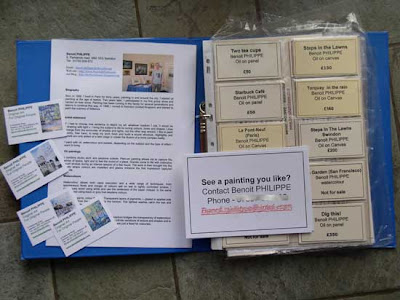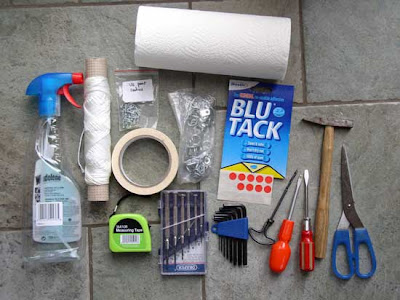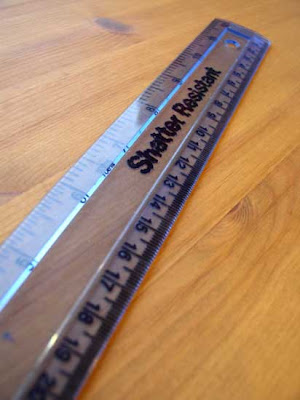When I set-up an exhibition, I want to have everything I need at hand so that I don’t waste time or have to come back. The photographs below show what I take with me when I set-up or take down an exhibition.
Binder with labels; signs with contact details on how to buy and business cards

From top to bottom and left to right: paper towel, window cleaner spay, cord, screws, masking tape, framing rings, Blu Tack, measuring tape, 6 piece precision slotted screwdrivers set, Allen keys, hand drill, screw drivers, framer hammer and a pair of scissors
- Repair kit for framed works: screws, screw drivers, hammer, string, rings and a pair of scissors.
- Measuring Tape: To check appropriate spacing between paintings.
- Window cleaner product and paper towels: A quick wipe to remove dust and finger prints from glass.
- Blu Tack®: I use it to stick the labels below the paintings as well as my bio information and the signs with my contact details for people who want to purchase a painting. Another use of this product consists in sticking two balls of Blu Tack at the bottom of a frame in order to make it steady. If paintings are hung on a metal wire, it may be the only way to keep them from being ajar.
- Precision screw drivers and Allen keys: Some hanging rods have small screws for the hook.
- Masking tape: Now, I use masking tape to seal-off bubble wrap around my paintings. I found that it works better than packing tape as it comes off without damaging the bubble wrap (this way, I am able to reuse it over and over).
In addition to what is shown in the photographs, I also have the following items:
- Digital camera: I always take a series of photographs of the exhibition when I finish setting it up. It serves a dual purpose: first for my record and future marketing use; then to complete my inventory and add the details of the exhibition to the comments section for each painting on display.
- Pen and paper (or a small notebook): You never know when you need to take some notes.
- Details for the venue: The email with the address of the exhibition venue, the name of the person in charge of the exhibition space and a telephone number to call in case of problems. If you are running late, you want to make sure you can call as a courtesy. The other time when a phone number is handy is when you don’t find the venue or the venue is closed the public and you cannot get in.
- Some large IKEA carrying bags: You can buy them cheaply from their store. These blue bags do not look nice, but they are sturdy and ideal with their long handles to carry paintings. I also put in the bags all the pieces of bubble wrap in as I unpack the paintings in order to keep the space tidy when I set-up.
They best way to make sure you have a complete kit ready at all time is to keep everything you need in a separate bag of crate. This means you may have to buy duplicate tools and material.
If you cannot afford the cost or do not have the space to get duplicate of some of your tools, then you should put together a checklist with the content of your kit. There is always something to do at the last minute and, with the pressure to get ready, you don’t want to forget a vital piece of equipment. Having a checklist will bring you peace of mind (why do you think surgeons and pilots use checklists?)
Art exhibition Exhibition toolkit








